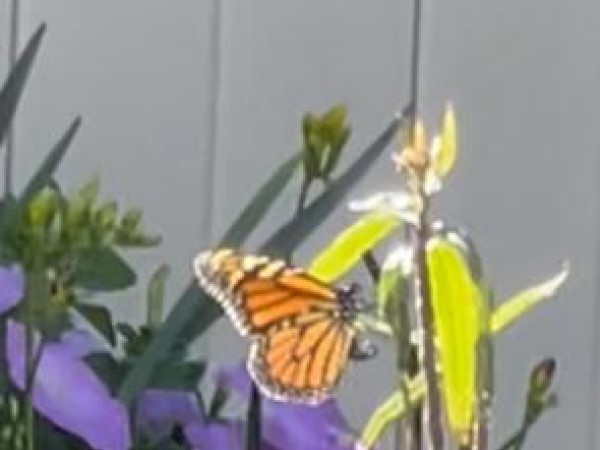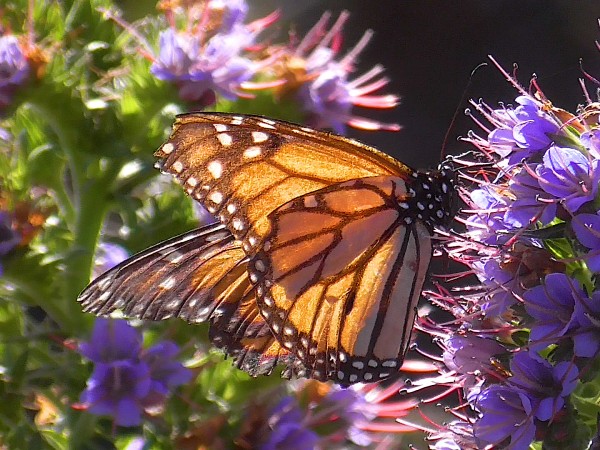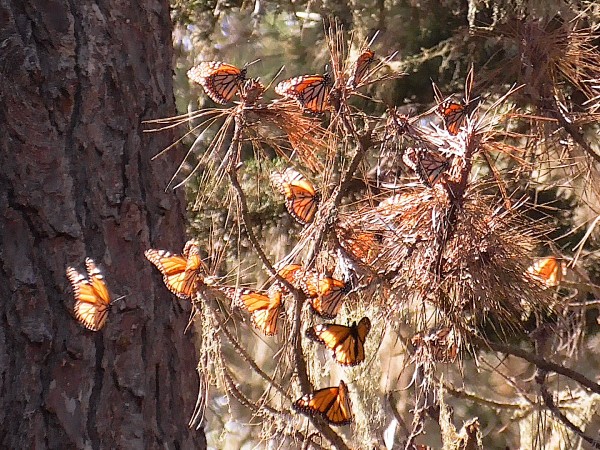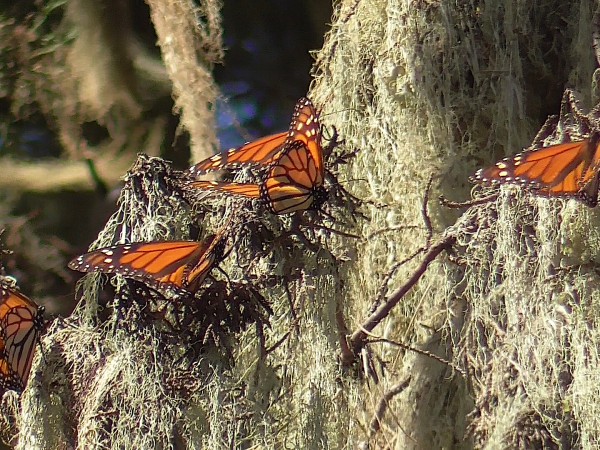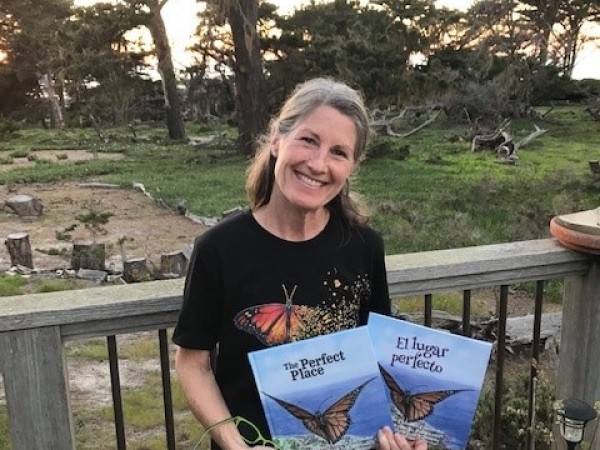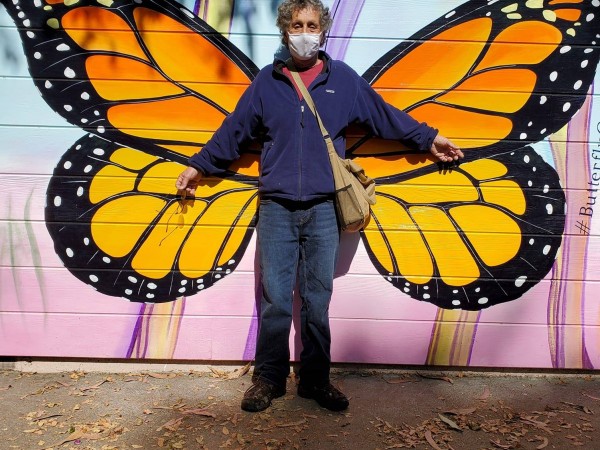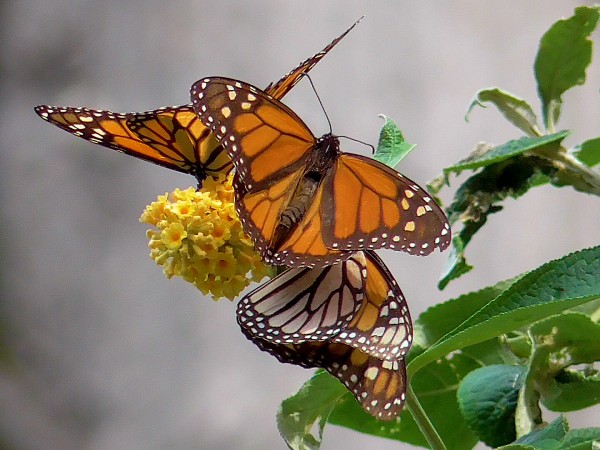Letter from Gail Morris: Western Monarch Winter 2021–22 Report #11
Published: 03/16/2022
Dear Western Monarch Friends,
Small numbers of monarchs are lingering at the coastal overwintering sites in California but others are reported further inland as the Spring Migration is underway. Native milkweed is also up in many locations welcoming gravid females to lay their eggs as they move through the landscape. Fruit trees in-flower along the way are offering an opportunity for monarchs to nectar to refill their energy needs as well. Keep an eye out for monarchs!
Western Monarch Sightings
Diane in Moreno Valley, California, saw a monarch on March 1. “First one of the year and next to our milkweed.”
Alice found a monarch in Palm Springs, California on March 4. “Spotted a very tattered adult monarch flying at the Moorten Botanical Garden in Palm Springs. Just visiting there so can't say if this area has a year round population or not.” Monarchs have been reported in the desert regions of California during the winter months but Alice’s report helps us all learn where and when they are seen.
Joyce in Mountain View, California found monarch larvae on March 5. “Counted 13 larvae at Google today. Most were on the small plants we reported several weeks ago. This was the largest. Several were on the base of the plants on stems or dead fallen leaves of other plants.”
Janet in Baywood-Los Osos, California, found one monarch on March 9. “Second monarch, first seen on March 1 at this location.”
Also on March 9, Nancy in Whittier reported one monarch. “I saw one adult Monarch flying around my front yard.” On March 10, Candace in nearby Pasadena, saw her first monarch of the year. “Saw at around noon in flight.” Zandra in Los Angeles, California saw one monarch on March 12. “Monarch came - fresh appearing wings - it just did a quick fly by. Further inland, just southeast of Riverside, in Moreno Valley, California, Diane saw 3 monarchs on the same day. “From about 11 am to 1 pm.”
Wendy in Temecula, California, spotted her first monarch of the year on March 11. “Observed one adult monarch butterfly at 2:45pm feeding on peach tree blossoms and early spring flowers around my garden today.”
Arizona is also reporting small numbers of monarchs. Jim, in Green Valley, Arizona reported one monarch. “March 12, 2022 - Green Valley, AZ. - La Posada at Central Park. 11:15 am. - 1:00 pm. 71 - 77 degrees, light breeze, full sun. Saw one male Monarch, preferred to rest on frost-bitten Oleander.”
Notes from the California Overwintering Sites
Pacific Grove
Stephanie Turcotte shares an update about the monarchs at the Butterfly Grove in Pacific Grove.
It was actually a beautiful morning to conduct our final monarch count in Pacific Grove for the ’21-'22 season. It was 40°F when I arrived, with filtered light beginning to hit the trees in various locations. The monarchs were quite spread out compared to other counts and clusters ranged in numbers from 5 to about 725 in one Monterey Cypress. The total came to 1,243 monarchs across 11 trees. We found a solitary, wing-torn male alive on a Eucalyptus twig on the ground, waiting to warm up. The number we ended with was very close to the first count of 1,316 we had on 10/16/21. Although this is the end of the weekly counting in our grove, we don’t have to say ‘good-bye’ to the monarchs just yet. The monarchs that are still here can be seen flying all around the neighborhood yards, enjoying the sunny weather and gathering nectar on blooming flowers and trees. I observe it even in my yard.
The fact that the monarchs came to Pacific Grove at all this year, especially in such high numbers, gives us hope that we can look forward to monarchs coming in October 2022. Until then, the community will do its best to care for and nurture the overwintering habitat, and the areas surrounding, to encourage monarchs to come and stay, not just next fall, but the year after that and for years to come. Hopefully monarch education and conservation continues to spread and encourages people in breeding habitats to do their part, as well. As monarchs have demonstrated to all of us, it’s all interconnected.
It has been my pleasure to share some of my observations and wonderful experiences over this monarch season. As always, the world of monarchs is fascinating and I learn something new every year I have the privilege of being a monarch docent.
(Enjoy the wonderful late season photos of monarchs at Pacific Grove by Robert Pacelli, too.)
Santa Cruz
Diana Magor gathered reports of early emerging milkweeds available to departing monarchs as they travel.
Diana reported that Rick Staub found Heartleaf Milkweed in bloom in late February in Solano County, in the Northeast Bay area. She also reported that Ron Allen, a UC Master Gardener in Maricopa County reported that only California Milkweeds had emerged in Madera and Mariposa counties with the earlies in Madera County on January 15 and in Mariposa County on January 14. A few were already flowering on February 18 and 15th respectively. The sightings of these early milkweeds is hopeful for monarchs flying through the region.
Diana also is seeing monarch activity in her yard. “Also, monarch’s are laying eggs on my potted milkweed plants, (mostly Narrowleaf and tropical, but including on the heartleaf seedlings I’m raising, just about every day here in Santa Cruz.”
Thanks!
A special Thank You to Stephanie Turcotte, Diana Magor and Robert Pacelli, for their expanded reports and photographs as well as everyone who submitted sightings and photos this week.
Spring Migration Sightings Are Important!
As the monarchs leave the California coast and move inland, we need your help to track their progress. Where are they now? If you are seeing monarchs, be sure to report to Journey North whether they are adults or eggs or larvae. Provide as much information as you can such as weather conditions (it’s okay to estimate). Your detailed description of what you see can include, but is not limited to, the monarch’s gender and activity and, if known, the type of flowers if they are nectaring. If you can, observe the condition of the wings – are they fresh and new or worn and tattered or something in between – helps us learn more about monarch age and survival. We realize it isn’t always possible, but please take a photo if you can. Thanks so much for your help.
Gail Morris is the Coordinator of the Southwest Monarch Study (www.swmonarchs.org), a Monarch Watch Conservation Specialist, and the Vice President of the Monarch Butterfly Fund, the Central Arizona Butterfly Association and the Western Monarch Advocates. The Western Monarch Population News is based on comments provided to Gail Morris. We hope to increase the number of sightings and therefore photos and comments entered into Journey North. We rely on the volunteers who communicate regularly with Gail and who agree to participate in our effort to increase awareness of the population of western Monarchs. You can reach her at gail@swmonarchs.org

